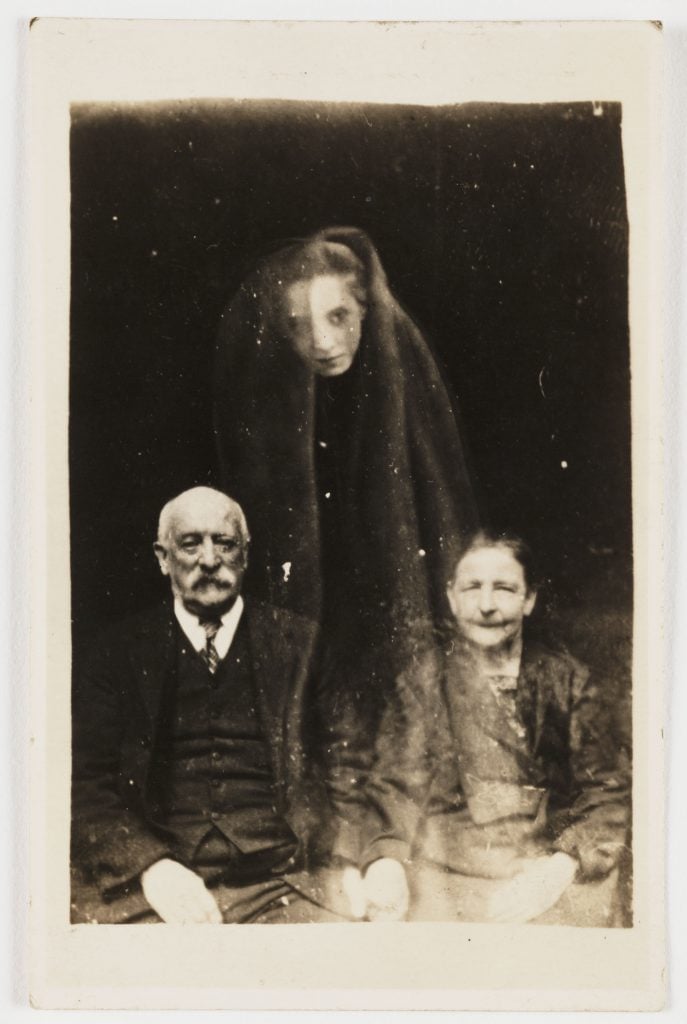William Mumler couldn’t explain it. He was experimenting with the photographic process for the first time, when a self-portrait he had taken developed to reveal a mysterious apparition of a girl at his side. Mumler was alone when he photographed himself in a friend’s studio: what or who was this ghostly figure then? Unperturbed, he shared the photo with his friends as a joke. That is, until he reached a spiritualist newspaper, which decided that he had, obviously, captured a ghost.
Where spiritualists saw a ghost, Mumler saw a business opportunity. By this point in 1861, the Boston-based silver engraver and amateur chemist already had a number of dubious ventures under his belt, including a homemade potion that he sold as a cure for dyspepsia. With his accidental creation of the world’s first haunted portrait, Mumler inadvertently became a pioneer in the field of spirit photography and its related industry.

A spirit photograph attributed to William Mumler, 1862–75. Photo: Sepia Times/Universal Images Group via Getty Images.
Mumler was soon charging Bostonians $10 to have a portrait taken with their deceased loved one (or some likeness). The origin story of his first spiritual photograph was fleshed out: The ghostly presence he captured was actually that of his cousin, deceased for 12 years, he said; his arm had also gone numb when he took the photo. In his new full-time job, he claimed that he could only take a handful of spirit photographs a day, because communicating with spirits was so tiring.
All this, of course, was an elaborate setup for the technique Mumler employed in the darkroom. When creating his first self-portrait, he had unintentionally used a plate (a surface coated with a light-sensitive emulsion, in use in early 19th-century photography) that was already exposed and had not been cleaned, resulting in overlapping images. Mumler most likely shot his subjects using similar double exposures, although his exact method and the chemicals he used remain unknown.

A double exposure photograph, ca. 1865. Photo: London Stereoscopic Company / Hulton Archive / Getty Images.
Photography, at this juncture, was a relatively new phenomenon. The daguerreotype, the first widely available photographic process, was only decades old, while advances in the field, from aerial photography to motion photography, ushered in previously unthinkable perspectives. The audience was enchanted even if disoriented. Mumler’s customers were gullible.
“Mumler sold himself as someone who couldn’t explain what was happening or why he was chosen to take these photos,” Peter Manseau, author of The Apparitionistshe told the History Channel. “He was as amazed as everyone else that suddenly his camera could take photos of ghosts.”

William H. Mumler, Mr. L.A. Bigelow (circa 1870). Photo: Sepia Times/Universal Images Group via Getty Images.
For two years Mumler ran a profitable business, then the skeptics arrived. A doctor who had posed for the photographer in 1863 recognized the ghost in the next photo as that of his wife, still among the living. A woman’s spirit photograph captured her brother who was lost during the Civil War, except he returned home later very much alive. PT Barnum, the famous showman, was but one of the voices who openly denounced Mumler for exploiting his clients’ pain.
In 1869, the spirit photographer was tried for fraud, but later acquitted because the prosecution failed to prove how he created his images. Mumler, in his testimony, insisted: “I have never had to deal with a hypocritical business where I did not value money.”

A spiritual photograph by William Hope, ca. 1920. Photo: SSPL/Getty Images.
Although the trial tarnished Mumler’s reputation, it failed to halt the development of spirit photography. His trial, or scam, was captured by medium photographers from Édouard Buguet in France to William Hope in the United Kingdom. Indeed, Mumler continued to receive clients at his practice well into the early 1870s, most notably Mary Todd Lincoln, Abraham’s widow, who reportedly arrived under an assumed name. His portrait of Mary Todd, dressed in a black cloak with the white apparition of her husband hovering behind her, remains his most famous. It was the last photo she sat for.

William H. Mumler, Mary Todd Lincoln (untitled spirit photograph with Abraham Lincoln’s shadow) (c. 1870). Photo: Harvard Art Museums/Fogg Museum, Special Collections Transfer, Fine Arts Library, Harvard College Library, Evert Jansen Wendell Bequest
More lasting, perhaps, was Mumler’s later invention of photoelectrotype plates – using woodcuts on a printing press instead of traditional engravings – which facilitated the printing of photographs on newsprint, a revolution for the publishing industry. By then, his days of spirit photography were behind him, as business and interest in spiritualism had waned in the years following the Civil War. He had conceived this last technique, which he called the Mumler Process, through his usual tinkering, in the same spirit of experimentation that produced his first ghostly image.
Mumler died in 1884 after a short illness. An obituary in Photographic times he was largely interested in his “inventive genius” and “wide reputation as a publisher of photographs” as founder of the Photo-Electrotype Company. His far more infamous origins were relegated to a pithy coda: “The deceased once acquired considerable notoriety in connection with spirit photographs.”
What inspired Mary Cassatt’s portraits of mothers? Why did Jackson Pollock paint on the floor? Eureka investigates the origins of artists’ most famous works and techniques, revealing how great artistic ideas are born.
#man #worlds #photo #ghost..